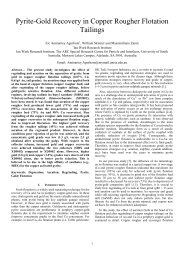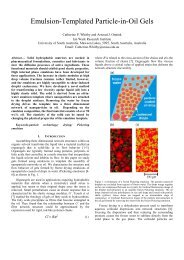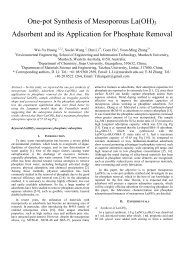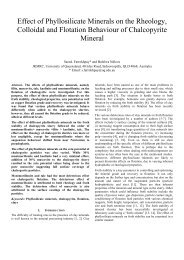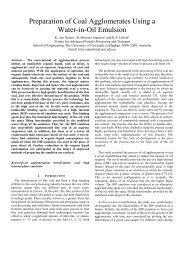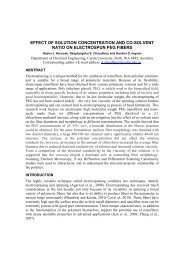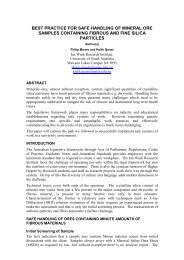a study on the calcination and sulfation behavior of limestone during ...
a study on the calcination and sulfation behavior of limestone during ...
a study on the calcination and sulfation behavior of limestone during ...
You also want an ePaper? Increase the reach of your titles
YUMPU automatically turns print PDFs into web optimized ePapers that Google loves.
Juan chen et al.<br />
higher than <strong>the</strong> ash c<strong>on</strong>tent, thus <strong>the</strong> gas-solid reacti<strong>on</strong> with SO2 became <strong>the</strong> dominant<br />
reacti<strong>on</strong>, which compensated <strong>the</strong> affect <strong>of</strong> ash. As can be seen in fig. 5, <strong>the</strong> fracti<strong>on</strong>s <strong>of</strong><br />
Ca-Si/Al compounds were decreased with SO2 additi<strong>on</strong> in both air <strong>and</strong> O2/CO2<br />
c<strong>on</strong>diti<strong>on</strong>s. The lower sulfati<strong>on</strong> extent in O2/CO2 than in air was fur<strong>the</strong>r c<strong>on</strong>firmed.<br />
Shaddix <strong>and</strong> Molina (2007) reported that O2 has a lower diffusi<strong>on</strong> rate (about 20% less)<br />
in CO2 layer than in N2. This phenomen<strong>on</strong> is explained by <strong>the</strong> lower SO2 diffusivity in<br />
O2/CO2 than in air affecting <strong>the</strong> transport <strong>of</strong> SO2 to <strong>the</strong> surface <strong>of</strong> <strong>the</strong> limest<strong>on</strong>e particle.<br />
Fig. 6 depicts <strong>the</strong> changes to <strong>the</strong> fracti<strong>on</strong>s <strong>of</strong><br />
unreacted limest<strong>on</strong>e <strong>and</strong> Ca-S with <strong>the</strong><br />
additi<strong>on</strong> <strong>of</strong> 1000 ppmV SO2 to air <strong>and</strong><br />
O2/CO2 c<strong>on</strong>diti<strong>on</strong>s. For <strong>the</strong> additi<strong>on</strong> 18%<br />
limest<strong>on</strong>e to coal in O2/CO2 case, <strong>the</strong><br />
reducti<strong>on</strong> <strong>on</strong> its unreacted fracti<strong>on</strong> is nearly<br />
equal to <strong>the</strong> increase in <strong>the</strong> percentage <strong>of</strong><br />
Ca-S, thus proving <strong>the</strong> sole significance <strong>of</strong><br />
<strong>the</strong> directi<strong>on</strong> sulfati<strong>on</strong> reacti<strong>on</strong> (3) for a<br />
high Ca/S molar ratio. For ano<strong>the</strong>r two low<br />
limest<strong>on</strong>e additi<strong>on</strong> percentages, in air<br />
c<strong>on</strong>diti<strong>on</strong> <strong>the</strong> unreacted fracti<strong>on</strong> up<strong>on</strong> SO2<br />
additi<strong>on</strong> is not changed, but <strong>the</strong> Ca-S<br />
fracti<strong>on</strong> is still increased. For O2/CO2, <strong>the</strong><br />
reducti<strong>on</strong> in <strong>the</strong> CaCO3 fracti<strong>on</strong> is far lower<br />
than <strong>the</strong> increase in <strong>the</strong> fracti<strong>on</strong> <strong>of</strong> Ca-S,<br />
particularly for <strong>the</strong> case <strong>of</strong> 1% limest<strong>on</strong>e added to coal, indicative <strong>of</strong> Ca-S not <strong>on</strong>ly from<br />
direct sulfati<strong>on</strong> reacti<strong>on</strong> (3), but also binding with sulfur from o<strong>the</strong>r approaches. Apart<br />
from <strong>the</strong> increase in <strong>the</strong> S/Ca molar ratio, <strong>the</strong> interacti<strong>on</strong> <strong>of</strong> coal ash with limest<strong>on</strong>e via<br />
reacti<strong>on</strong> (16) <strong>and</strong> (17) may also be <strong>the</strong> cause for this phenomen<strong>on</strong>. The formed Ca-Al-Si<br />
could be shed away from limest<strong>on</strong>e surface, ensured <strong>the</strong> exposure <strong>of</strong> fresh surface <strong>of</strong><br />
limest<strong>on</strong>e to undergo decompositi<strong>on</strong> <strong>and</strong> react with SO2. Besides that, our previous<br />
results (Zhang et al. 2002) c<strong>on</strong>firmed that <strong>the</strong> added limest<strong>on</strong>e reacted with<br />
aluminosilicate in <strong>the</strong> ash <strong>and</strong> fixed into calcium aluminosilicate, rich in calcium, can<br />
c<strong>on</strong>tinue to react with gaseous SO2 to remove it.<br />
5. CONCLUSIONS<br />
18% 5% 1%<br />
mass percentage <strong>of</strong> CaCO3 in coal<br />
Mechanisms for calcinati<strong>on</strong> <strong>and</strong> sulfati<strong>on</strong> <strong>of</strong> limest<strong>on</strong>e added at <strong>the</strong> mass ratios <strong>of</strong> 18%,<br />
5% <strong>and</strong> 1% to a brown coal <strong>during</strong> air <strong>and</strong> O2/CO2 mixture (27/73) in a lab-scale DTF<br />
have been investigated. The major c<strong>on</strong>clusi<strong>on</strong>s are drawn as follows: (1) The high CO2<br />
partial pressure in an oxy-fuel furnace played a negative role <strong>on</strong> calcinati<strong>on</strong>s <strong>of</strong><br />
limest<strong>on</strong>e. However, increase in <strong>the</strong> local temperature <strong>of</strong> limest<strong>on</strong>e particles through <strong>the</strong><br />
radiative heat from coal flame favoured <strong>the</strong> decompositi<strong>on</strong> <strong>of</strong> limest<strong>on</strong>e to a level<br />
similar with that achieved in air in a nominal gas residence time <strong>of</strong> approximately 4 s. (2)<br />
The ash-forming metals in coal played an important role <strong>on</strong> <strong>the</strong> calcinati<strong>on</strong> <strong>and</strong> sulfati<strong>on</strong><br />
<strong>of</strong> limest<strong>on</strong>e <strong>during</strong> oxy-fuel combusti<strong>on</strong>. The direct interacti<strong>on</strong> between ash-forming<br />
metals particularly aluminium <strong>and</strong> silic<strong>on</strong> <strong>and</strong> limest<strong>on</strong>e was more favored in <strong>the</strong> CO2dominant<br />
gas atmosphere than in air, which in turn promoted <strong>the</strong> decompositi<strong>on</strong> <strong>of</strong><br />
limest<strong>on</strong>e. The Ca-Al/Si formed could be partially shed away from limest<strong>on</strong>e surface to<br />
ensure <strong>the</strong> exposure <strong>of</strong> fresh surface to c<strong>on</strong>tinue decompositi<strong>on</strong> <strong>and</strong> sulfati<strong>on</strong>. However,<br />
Reducti<strong>on</strong>/Increase in fracti<strong>on</strong>, %<br />
24<br />
18<br />
12<br />
6<br />
0<br />
-6<br />
-12<br />
-18<br />
-24<br />
reducti<strong>on</strong> in unreacted CaCO3(Air), %<br />
increase in Ca-S(Air), %<br />
reducti<strong>on</strong> in unreacted CaCO3(O2/CO2), %<br />
increase in Ca-S(O2/CO2), %<br />
Fig.6 Changes to <strong>the</strong> fracti<strong>on</strong>s <strong>of</strong> unreacted<br />
CaCO3 <strong>and</strong> CaSO4 up<strong>on</strong> SO2<br />
additi<strong>on</strong> to air <strong>and</strong> O2/CO2<br />
8



